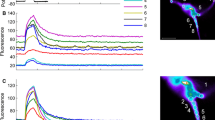Summary
Excitatory postsynaptic currents (EPSCs) were measured as clamp current of muscle fibers or by focal extracellular recording. In the control bathing solution the voltage dependence of the EPSC was nearly linear in the potential range between −160 to −40 mV, in most experiments the slope of this relation decreased at potentials more negative than the resting potential. In 5×Ca++ solution at potentials more negative than −70 to −100 mV the slope of the current voltage relation of the EPSC was zero or negative. The reversal potentials for the EPSCs, extrapolated from the current voltage relation, were at +33 mV (S.D.±32 mV) both in 1×Ca++ and in 5×Ca++ solution.
The declining phase of EPSCs was slowed by depolarization and shortened by hyperpolarization, its time constant increasing by about 100% between −160 mV and −40 mV.
Excitatory postsynaptic currents also were elicited by glutamate-pulses (g-EPSCs). In 1×Ca++ and in 5×Ca++ solutions the amplitude of the g-EPSCs showed a voltage dependence like that of the EPSCs. In 10×Ca++ solution (10% normal Na+) synaptic current was reduced to about 50%. The current voltage relation was very flat and showed a negative slope for high negative potentials.
It is concluded that Na+-, Ca++- and K+-ions contribute to the EPSC. Synaptic sodium and/or calcium conductance seems to decrease at potentials more negative than the resting potential.
Similar content being viewed by others
References
Anderson, C. R., Stevens, C. F.: Voltage clamp analysis of acetylcholine produced end-plate current fluctuations at frog neuromuscular junction. J. Physiol. (Lond.)235, 665–691 (1973)
Del Castillo, J., Katz, B.: Statistical factors involved in neuromuscular facilitation and depression. J. Physiol. (Lond.)124, 574–585 (1954)
Dudel, J.: Decrease of membrane conductance during excitation in high Ca++ at the crayfish neuromuscular junction. Pflügers Arch.339, R 71 (1973)
Dudel, J., Kuffler, S. W.: Excitation at the crayfish neuromuscular junction with decreased membrane conductance. Nature (Lond.)187, 246–247 (1960)
Dudel, J., Kuffler, S. W.: The quantal nature of transmission and spontaneous miniature potentials at the crayfish neuromuscular junction. J. Physiol. (Lond.)155, 514–529 (1961)
Dudel, J., Morad, M., Rüdel, R.: Contractions of single crayfish muscle fibers induced by controlled changes of membrane potential. Pflügers Arch. ges. Physiol.299, 38–51 (1968)
Dudel, J., Peper, K., Rüdel, R., Trautwein, W.: Excitatory membrane current in heart muscle (Purkinje fibers). Pflügers Arch. ges. Physiol.292, 255–273 (1966)
Eccles, J. C.: The physiology of synapses. Berlin-Göttingen-Heidelberg: Springer 1964
Magleby, K. L., Stevens, C. F.: The effect of voltage on the time course of end-plate currents. J. Physiol. (Lond.)223, 151–171 (1972)
New, W., Trautwein, W.: Inward membrane currents in mammalian myocardium. Pflügers Arch.334, 1–23 (1972)
Orkand, R. K.: The relation between membrane potential and contraction in single crayfish muscle fibres. J. Physiol. (Lond.)161, 143–159 (1962)
Paupardin-Tritsch, D., Gerschenfeld, H. M.: Neuronal responses to 5-hydroxytryptamine resulting from membrane permeability decreases. Nature New Biol244, 171–173 (1973)
Reuben, J. P., Gainer, H.: Membrane conductance during depolarizing postsynaptic potentials of crayfish muscle fibres. Nature (Lond.)193, 142–143 (1962)
Takeuchi, A., Onodera, K.: Reversal potentials of the excitatory transmitter onl-glutamate at the crayfish neuromuscular junction. Nature New Biol.242, 124–126 (1973)
Takeuchi, A., Takeuchi, N.: Further analysis of relationship between end-plate potential and end-plate current. J. Neurophysiol.23, 397–402 (1960)
Takeuchi, A., Takeuchi, N.: The effect on crayfish muscle of iontophoretically applied glutamate. J. Physiol. (Lond.)170, 296–317 (1964)
Takeuchi, A., Takeuchi, N.: Actions of transmitter substances on the neuromuscular junctions of vertebrates and invertebrates. Biophysics3, 45–95 (1972)
Taraskevich, P. S.: Reversal potentials ofl-glutamate and the excitatory transmitter at the neuromuscular junction of the crayfish. Biochim. biophys. Acta (Amst.)241, 700–703 (1971)
Weight, F. F., Votova, J.: Slow synaptic excitation in sympathetic ganglion cells: Evidence for synaptic inactivation of potassium conductance. Science170, 755–758 (1970)
Author information
Authors and Affiliations
Additional information
This investigation was supported by a grant of the Deutsche Forschungsgemeinschaft (Du 24/14).
Rights and permissions
About this article
Cite this article
Dudel, J. Nonlinear voltage dependence of excitatory synaptic current in crayfish muscle. Pflugers Arch. 352, 227–241 (1974). https://doi.org/10.1007/BF00590488
Received:
Issue Date:
DOI: https://doi.org/10.1007/BF00590488




